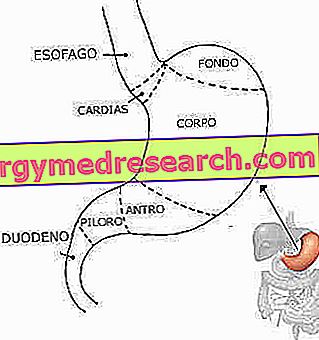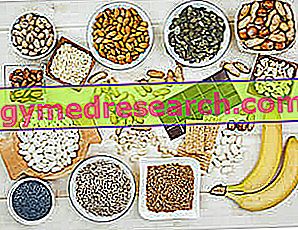Anatomy
The stomach is about 25 cm long and is anatomically divided into the following parts:
- the bottom, placed above and to the left of the junction between the esophagus and stomach (esophagus-gastric);
- the cardia, corresponding to the esophagus-gastric junction;
- the body, which represents the largest portion of the stomach, and which lies between the bottom and the antrum;
- the antrum, the final portion of the stomach, which extends from the small curvature to the pylorus;
- the pylorus, which represents the border between the stomach and the duodenum.

The stomach, as well as the other abdominal organs, is covered by the peritoneum, which is a serous and fibrous structure which has the function of protecting it and keeping it adherent to the abdominal wall and to the organs close to it. The gastric wall is made up of four fundamental layers, starting from the outside and going true to the inside:
- the serous lining of the visceral peritoneum (that portion of peritoneum adhering to the organ);
- the muscular layer, which has three concentric layers of fibers (from the outside towards the inside: oblique, longitudinal and circular);
- the submucosa, rich in small blood and lymphatic vessels;
- the muscularis mucosae, a small layer of muscular tissue that separates the mucosa from the submucosa;
- the mucosa, which is the innermost layer of the stomach, is made up of a great variety of cells: the muciparous, mucous secretion, the parietal ones, which produce hydrochloric acid, the main ones, which secrete pepsinogen, and the G cells that produce gastrin .
The pylorus continues with the duodenum, which is the first part of the small intestine. It is about 30 cm long and its wall is made up of 5 concentric layers. Starting from the outside towards the inside they are distinguished:
- the serous tunic, represented by the visceral peritoneum;
- the muscular habit, consisting of two concentric layers of smooth muscle cells (the external layer with a longitudinal course and the internal one with a circular course);
- the submucosal cassock, composed mainly of elastic fibers, among which the duodenal glands secreting weakly alkaline mucus (basic) and pepsinogen are located.
- the muscularis mucosae ;
- the mucous membrane, made up of epithelial cells.
The duodenal epithelium is composed of a very diverse cell population: enterocytes (intestinal cells absorbing nutrients) represent the prevalent cellular element; among them muciparous cells are produced, producing mucus, immune cells and endocrine cells.
Vascularization and innervation
The stomach has a rich arterial vascular network that penetrates inside the gastric wall, dividing into smaller and smaller vessels that run along the small and large gastric curvature. The innervation is given by the vagus nerve: the importance of the integrity of the vagal innervation of the stomach in controlling acid secretion is documented by the clear reduction, after vagotonia (removal of the gastric portion of the vagus nerve) of the production of hydrochloric acid.
Physiology
The stomach performs many important functions:
- acts as a "container" for foods coming from the esophagus, allowing even large quantities of food to be ingested;
- it causes the mixing and progression towards the bolus duodenum (ie the name that takes food from within the stomach) food, mixed with gastric juice;
- the digestion of proteins and carbohydrates begins, using pepsinogen and secreted hydrochloric acid;
- it has the function of absorbing some substances;
- performs endocrine secretion activity.
In the duodenum the biliary and pancreatic secretions are poured through the ducts that put it in communication with the gall bladder and the pancreas, and the conditions of alkaline environment (basic) are achieved with a high concentration of enzymes suitable for the digestion of proteins, fats and carbohydrates. The duodenum also has functions of absorption and endocrine secretion.
Important aspects of stomach physiology are peptic acid secretion, hormonal secretion, motility, food digestion and other functions.



